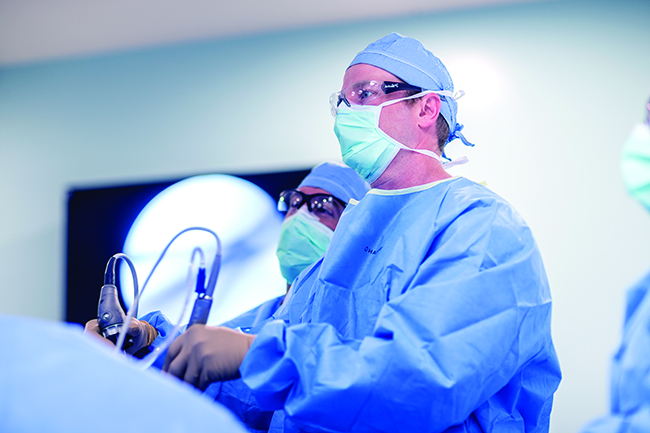You talked with your doctor about the hip pain you’ve been experiencing, and he recommended an arthroscopy. But what is that exactly?
Arthroscopy comes from two Greek words blended together—the words “arthro” and “skopein.” The former means “joint,” while latter means “to look.” So, taken together, the word means “to look within the joint.”
“An arthroscopy is a procedure where we use a camera to evaluate joint injuries,” says Brandon Cincere, MD, board-certified orthopaedic surgeon and clinical assistant professor for UT College of Medicine, who specializes in hip arthroscopy. “These procedures are minimally invasive because we’re using small incisions, instruments and cameras to get a closer look at an injury.”
A small incision is made in the patient’s skin. Then the orthopaedic surgeon inserts tiny instruments containing a lens and lighting system through the incision. These tools magnify and illuminate the inside of the joint, then the camera transmits those images in real-time so that the surgeon is able to literally see inside the joint.
“There are many benefits to arthroscopy,” Dr. Cincere says. “It’s minimally invasive and less traumatic on the joints —and it allows a surgeon to evaluate the joints thoroughly.”
Arthroscopy allows a doctor to diagnose both acute and chronic injuries, meaning those that have occurred over time.
Increasingly, arthroscopy is being used as a treatment method in and of itself. While inside the joint, surgeons can make repairs that often alleviate the issue.
“In the past, arthroscopy used to be more of a diagnostic tool, but now we generally have an idea of what needs to be done, repair-wise,” Dr. Cincere says. “Through arthroscopy, we can repair cartilage defects and meniscal tears, as well as stabilize the joints.”
Arthroscopy can be used to treat many different conditions and areas of the body, including the shoulders, hips, knees and ankles. Some common injuries or conditions treated include:
- Hips: inflamed synovial tissue, labral tears, torn cartilage
- Shoulders: rotator cuff tears and recurrent dislocations
- Knees: meniscal tears, anterior cruciate ligament tears with instability and cartilage injuries
- Ankles: inflamed synovial tissue, ligament damage
Arthroscopic procedures can also be used to scope out and remove loose bodies of bone and cartilage, which may be found in the hip, knee, shoulder, elbow, or ankle. “Arthroscopy is not for everybody — it can’t be used to treat arthritis, for one,” Dr. Cincere says. “But it’s a valuable procedure that allows fellowship-trained sports medicine professionals to scope out injuries and often treat them, all on a minimally invasive basis.”
If you’re in need of arthroscopy or another type of orthopaedic procedure, the Erlanger Orthopaedic Institute offers nationally recognized excellence right here at Erlanger East Hospital. Find out more about what we offer at erlanger.org/ortho.







